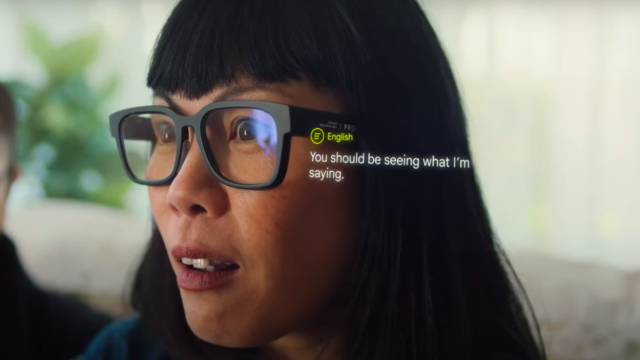Get ready for the return of the Glassholes.
Google says it’s preparing to start testing new prototype augmented reality glasses in public next month. The renewed push for public testing comes despite a tidal wave of public backlash against the company’s first consumer smartglasses debacle nearly a decade ago.
In a blog post this week, Google said lab environments were too simply too restrictive and hopes public testing, “will allow us to better understand how these devices can help people in their everyday lives.” This real-world testing could supposedly help Google flesh out its AR navigation tools and account for factors like weather and congested street intersections. These glasses won’t be available to just anyone though. Google said it will begin testing its prototypes with around a dozen Google staffers and trusted testers with an apparent focus on “ensuring the privacy of the testers and those around them.”
The first wave of test glasses will feature in-lens displays and cameras, but won’t support photography and videography. Google says its glasses will be able to scan real-world image data, like a restaurant menu in a foreign language, and use its AR capabilities to translate it in real-time. According to a separate Google support page, the company explained it will usually delete this data but admitted it could be used for “analyses and debugging.” Google says it will scrub any saved data for sensitive content like faces and licence plate numbers.
Like Meta’s Ray Ban Stories released last year, Google’s prototypes are intended to resemble traditional, slightly less dweeby glasses. Google teased a new pair of AR glasses capable of translating language in real-time at its I/O 2022 event but was lacking in details beyond that. Recent reporting in The Verge suggests Google reportedly plans to ship its first AR glasses by 2024.
Google’s second attempt at public-wearing face wearable tech comes nearly a decade after first rolling out its failed Google Glass AR headsets. In that case, Google Glass owners quickly earned the nickname “Glassholes” over concerns its wearers were obnoxiously recording the day-to-day activities of those around them without their consent. They also made you look dumb as hell. The Glassholes struck a nerve, with multiple users at the time reported being assaulted and having their glasses ripped off their faces by annoyed bystanders.
The general public at the time was deeply sceptical of Google Glass’ privacy implications. An overwhelming 85% of U.S. adults surveyed by Rasmussen Reports in 2014 expressed major privacy concerns over the glasses. Movie theatres, restaurants, and bars event went so far as to ban the glasses from their businesses.
Now, in 2022, Google’s hoping public attitudes toward walking recording machines have waned. While there isn’t great hard data out there on the public’s general feelings towards smart glasses and AR headsets, the general trend since the Google Glass era has favoured less privacy, not more. The relative success of Meta’s recent Ray Ban Stories smartglasses also suggests the tides might be turning for public wearables. While those $US300 ($416) glorified Go-Pros aren’t necessarily flying off shelves, they have managed to achieve some market viability without the same debilitating backlash that plagued Google Glass seven years ago.
In its recent inaugural Human Rights report, Meta says it conducted an internal analysis prior to the glasses’ release to assess the potential human rights risks they posed and acted on some of those recommendations to at least pay lip service to concerns over public surveillance. Those glasses now feature a faint white light to signal when users are recording video which admittedly isn’t much, but still likely would not have occurred without urging from privacy advocates. To be clear, Meta’s Ray Ban Stories don’t currently feature true AR capabilities, though Meta is reportedly moving in that direction with future models.
Whether or not Google can fully escape the damage dealt by the Glass era remains an open question. One thing’s for sure though, if some poor Google developer does get socked in the face while wearing one of these new prototypes, we’ll be the first to let you know.
